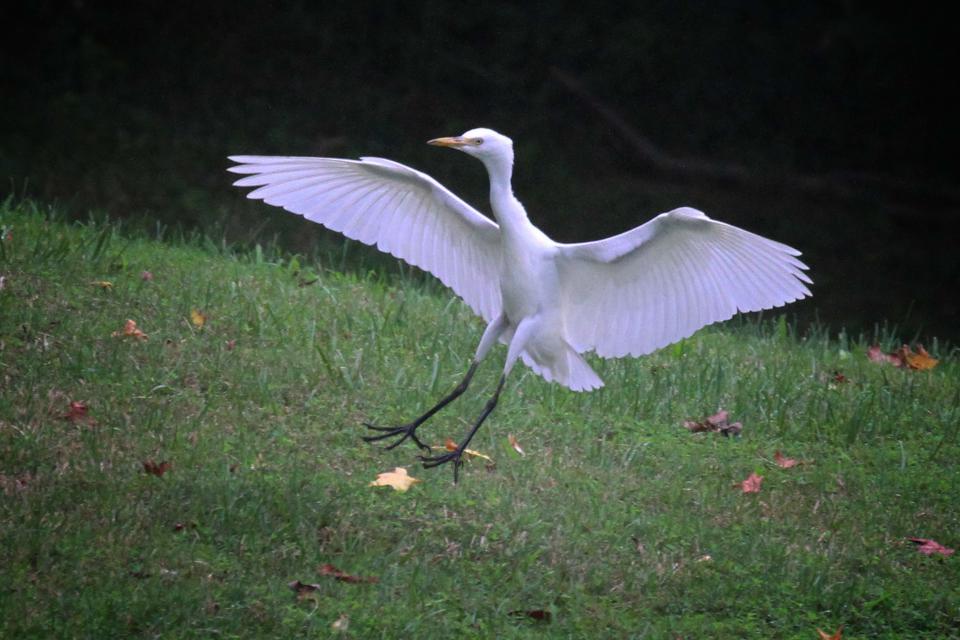How did cattle egrets get from Africa to the Evansville area?
Fall often sees certain larger-species breeding birds come up from the south and wander through the Tri-State, moving (illogically, it would seem) in a direction opposite to the birds’ ultimate migratory destination.
Juveniles and adults alike frequently roam well beyond their breeding range, foraging, exploring new territories, perhaps considering alternate destinations for the next season.
As a result, sighting a lone juvenile cattle egret locally last week wasn’t a total surprise.
In likely the most astonishing range expansion in the world, the birds that hailed originally from Africa have crossed continents and oceans, entirely under their own power, to take up residence everywhere. In 1941 they reached North America and were first recorded nesting in 1953. Since then, they’ve become, according to Birds of the World online (BOW), “one of the most abundant of the North American herons, showing up as far north as Alaska and Newfoundland.”
The odd name, cattle egret, reflects this long-legged two-foot tall all-white bird’s companionship with grazing animals. Worldwide, cattle egrets follow many grazers: elephants, giraffes, hippos, camels, water buffalo, bison, horses − and cattle. Here, the nearby cow pasture likely helped direct the egret to our premises.
Gregarious creatures, cattle egrets nest in dense colonies, high in trees. Their nighttime roosts sometimes host nearly 1,000 birds, explaining, perhaps, why 18 of its fellows joined our single bird by nightfall.

While cattle egrets sighted during migration in our area most likely follow a central migratory route, generally from Kansas east to Alabama and south to Panama, ornithologists admit that “detailed patterns of dispersal and timing of movements remain unclear.” That’s because even with more than 66,000 birds banded or color-marked over a 50-year period, only 0.9 percent were ever recovered or sighted. Tracking remains elusive.
Reported sightings indicate fall migration for cattle egrets stretches from early August through late November. Another statistic, however, is even more telling: The young tend to disperse over startlingly great distances from their natal colonies, sometimes up to an astonishing 3,000 miles. Their North American range continues to expand.
Local news: Evansville's next mayor could get a big raise: 4 takeaways from day one of budget hearings
Cattle egrets don’t fit the typical water-bird image of egrets. Yes, they may seek out areas near swamps, lakes, and other marine sites, but they don’t go in the water and don’t eat from the water. Instead, they prefer primarily insects, especially grasshoppers and crickets, plus other invertebrates, fish, frogs, and birds. And therein lies their attraction to cattle. Big mammals stomp through grasslands, stirring up insects, making easy pickings for the birds.
Because of their unusual behavior, cattle egrets attract a particular scientific interest, particularly as a bioindicator of environmental conditions. Somehow, these birds, without human assistance,have managed to establish themselves successfully across vast geographic areas and in varied habitats. As noted in BOW online, “Apparent keys to [the birds’] success are its dispersal tendencies, gregariousness, diet, foraging adaptability ... and its breeding adaptability and success.”
So, our lovely little visitor could have grown up well to our south, is spending the fall exploring vast territories, and will finally head back south − way south − to winter, possibly to the Gulf Coast or even Central America. Since these egrets show almost no site loyalty, next spring could find this youngster-now-grown-up, migrating to Texas or North Carolina − or even to a different continent. They’re not afraid to travel.
For more information about birds and bird habitat, see Sharon Sorenson’s books How Birds Behave, Birds in the Yard Month by Month, and Planting Native to Attract Birds to Your Yard. Follow daily bird activity on Facebook at SharonSorensonBirdLady, or email her at chshsoren@gmail.com.
This article originally appeared on Evansville Courier & Press: How did cattle egrets get from Africa to the Evansville area?

